This post contains affiliate links.
Embarking on the path of acrylic painting can be a transformative journey, offering a gateway to express creativity and emotions on the canvas. As a novice in the world of art, mastering fundamental painting techniques can significantly enhance the quality and depth of your artwork. Acrylics, known for their versatility and vibrant colors, provide a medium where experimentation and expression go hand in hand. This comprehensive guide outlines 14 essential methods that beginners should master to refine their painting skills, ranging from basic techniques to more advanced approaches.
14 Acrylic Painting Methods
 Texturing with Stiff Brushes or Paper Towels: The use of stiff-bristle brushes or paper towels for applying thick paint can create unique and random textures. This method is perfect for simulating natural elements like sandy beaches, rough surfaces, or fluffy clouds. By using varied tones of the same color, you can add complexity and realism to these textures.
Texturing with Stiff Brushes or Paper Towels: The use of stiff-bristle brushes or paper towels for applying thick paint can create unique and random textures. This method is perfect for simulating natural elements like sandy beaches, rough surfaces, or fluffy clouds. By using varied tones of the same color, you can add complexity and realism to these textures. Stippling for Detailed Textures: Stippling involves the application of tiny dots to form textures that appear solid from a distance. This meticulous technique is excellent for adding realistic finishes to objects like fruits, foliage, or for creating abstract designs. Varying the size and color of the dots can produce different effects, such as highlighting on waves or creating a starry night sky.
Stippling for Detailed Textures: Stippling involves the application of tiny dots to form textures that appear solid from a distance. This meticulous technique is excellent for adding realistic finishes to objects like fruits, foliage, or for creating abstract designs. Varying the size and color of the dots can produce different effects, such as highlighting on waves or creating a starry night sky. Dripping and Acrylic Pouring for Dynamic Effects: The dripping and pouring techniques in acrylic painting are ways to create dynamic and fluid art. By layering and manipulating wet paint, artists can achieve effects resembling rain, melting objects, or even psychedelic backgrounds. This method is great for those who enjoy experimentation, resulting in marble-like textures or swirling patterns that are unique to each piece.
Dripping and Acrylic Pouring for Dynamic Effects: The dripping and pouring techniques in acrylic painting are ways to create dynamic and fluid art. By layering and manipulating wet paint, artists can achieve effects resembling rain, melting objects, or even psychedelic backgrounds. This method is great for those who enjoy experimentation, resulting in marble-like textures or swirling patterns that are unique to each piece. Lifting Paint for Soft Effects: ‘Lifting’ is a technique where wet paint is removed to create soft effects, such as clouds, mist, or reflections in water. This method encourages experimentation with various tools, like wet paper towels or sponges, and is ideal for beginners looking to explore different effects in their paintings.
Lifting Paint for Soft Effects: ‘Lifting’ is a technique where wet paint is removed to create soft effects, such as clouds, mist, or reflections in water. This method encourages experimentation with various tools, like wet paper towels or sponges, and is ideal for beginners looking to explore different effects in their paintings. Creating Clean Lines with Painter’s Tape: Painter’s tape can be an invaluable tool for achieving precise lines and shapes. This method is especially useful for geometric patterns, architectural elements, or creating silhouettes, ensuring sharp and neat finishes in your artwork.
Creating Clean Lines with Painter’s Tape: Painter’s tape can be an invaluable tool for achieving precise lines and shapes. This method is especially useful for geometric patterns, architectural elements, or creating silhouettes, ensuring sharp and neat finishes in your artwork. Splatter Painting for Dynamic Textures: Splattering paint onto the canvas can add a lively and natural touch to your work. It’s suitable for depicting elements like starry skies, splashes of water, or sand. This technique can be varied using tools like a sponge or rag to create different splatter effects.
Splatter Painting for Dynamic Textures: Splattering paint onto the canvas can add a lively and natural touch to your work. It’s suitable for depicting elements like starry skies, splashes of water, or sand. This technique can be varied using tools like a sponge or rag to create different splatter effects. Dry Brushing for Distinctive Textures: Dry brushing involves using a dry brush on a dry canvas. This method is ideal for creating a sense of ruggedness and texture, often used to depict natural scenes or objects with a rough surface. It adds a gritty, realistic touch, enhancing the tactile quality of your paintings.
Dry Brushing for Distinctive Textures: Dry brushing involves using a dry brush on a dry canvas. This method is ideal for creating a sense of ruggedness and texture, often used to depict natural scenes or objects with a rough surface. It adds a gritty, realistic touch, enhancing the tactile quality of your paintings. Using Palette Knives for Creative Textures: Palette knives are not limited to mixing paint; they can also be used to apply paint, creating smooth areas, ridges, or thin lines. The versatility of palette knives offers a range of textural possibilities, from creating thick impasto effects to delicate, smooth finishes.
Using Palette Knives for Creative Textures: Palette knives are not limited to mixing paint; they can also be used to apply paint, creating smooth areas, ridges, or thin lines. The versatility of palette knives offers a range of textural possibilities, from creating thick impasto effects to delicate, smooth finishes. Detailing with a Fine, Wet Brush: For intricate and precise details, a fine, wet brush is essential. This tool allows for the creation of sharp lines, fine points, and delicate outlines, perfect for adding those final touches that bring a painting to life.
Detailing with a Fine, Wet Brush: For intricate and precise details, a fine, wet brush is essential. This tool allows for the creation of sharp lines, fine points, and delicate outlines, perfect for adding those final touches that bring a painting to life. Highlighting Dark Areas with Lighter Paint Layers: Using lighter layers of paint in darker sections of your painting can add depth and dimension. This technique helps in enhancing the overall three-dimensional feel of your artwork, making it more lifelike and dynamic.
Highlighting Dark Areas with Lighter Paint Layers: Using lighter layers of paint in darker sections of your painting can add depth and dimension. This technique helps in enhancing the overall three-dimensional feel of your artwork, making it more lifelike and dynamic. Layering for Depth: The quick-drying nature of acrylic paints is advantageous for layering. This method allows for the creation of underpaintings and subsequent layers, adding depth and complexity to your painting. Layering can also be used to correct mistakes or add details as your work progresses.
Layering for Depth: The quick-drying nature of acrylic paints is advantageous for layering. This method allows for the creation of underpaintings and subsequent layers, adding depth and complexity to your painting. Layering can also be used to correct mistakes or add details as your work progresses. Color Mixing and Charting: Understanding color theory and mixing is fundamental in painting. By mixing primary colors, a wide range of hues can be created. Keeping a personal color mixing chart can be a useful reference for future projects, helping you to recreate specific shades and understand color relationships.
Color Mixing and Charting: Understanding color theory and mixing is fundamental in painting. By mixing primary colors, a wide range of hues can be created. Keeping a personal color mixing chart can be a useful reference for future projects, helping you to recreate specific shades and understand color relationships. Using Varied Tones of the Same Color: Experimenting with different shades and tints of a few colors can produce visually striking results. This approach simplifies the color palette but can create paintings with a strong visual impact, focusing on light, shadow, and form rather than an extensive range of colors.
Using Varied Tones of the Same Color: Experimenting with different shades and tints of a few colors can produce visually striking results. This approach simplifies the color palette but can create paintings with a strong visual impact, focusing on light, shadow, and form rather than an extensive range of colors.
In conclusion, mastering these 14 essential acrylic painting methods can significantly elevate the skills of novice artists. Each technique offers a different way to explore the medium of acrylics, encouraging creativity and experimentation. By practicing these methods, beginners can develop their unique style, enhance their artistic abilities, and create captivating artworks that express their individuality and vision. Remember, the journey of art is endless, and every new technique learned is a step forward in this exciting and fulfilling path.
Source Links
- https://www.allartschools.com/benefits-of-attending-art-schools/
- https://www.chitkara.edu.in/blogs/the-advantages-of-fine-arts-education-nurturing-creative-excellence/
- https://inventivaworks.com/blog/2022/1/13/five-reasons-to-take-an-art-class-whether-you-are-a-grownup-or-a-child
This post contains affiliate links.


 Texturing with Stiff Brushes or Paper Towels: The use of stiff-bristle brushes or paper towels for applying thick paint can create unique and random textures. This method is perfect for simulating natural elements like sandy beaches, rough surfaces, or fluffy clouds. By using varied tones of the same color, you can add complexity and realism to these textures.
Texturing with Stiff Brushes or Paper Towels: The use of stiff-bristle brushes or paper towels for applying thick paint can create unique and random textures. This method is perfect for simulating natural elements like sandy beaches, rough surfaces, or fluffy clouds. By using varied tones of the same color, you can add complexity and realism to these textures.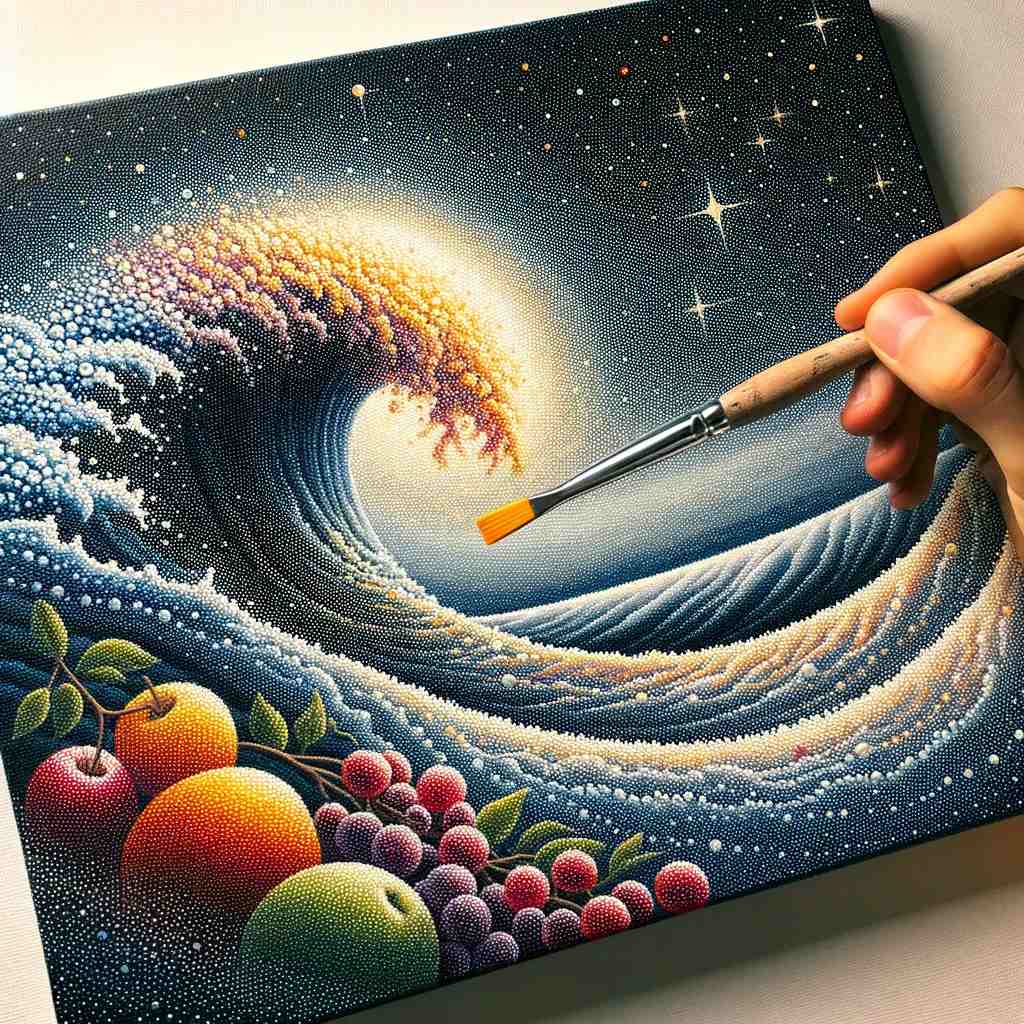 Stippling for Detailed Textures: Stippling involves the application of tiny dots to form textures that appear solid from a distance. This meticulous technique is excellent for adding realistic finishes to objects like fruits, foliage, or for creating abstract designs. Varying the size and color of the dots can produce different effects, such as highlighting on waves or creating a starry night sky.
Stippling for Detailed Textures: Stippling involves the application of tiny dots to form textures that appear solid from a distance. This meticulous technique is excellent for adding realistic finishes to objects like fruits, foliage, or for creating abstract designs. Varying the size and color of the dots can produce different effects, such as highlighting on waves or creating a starry night sky.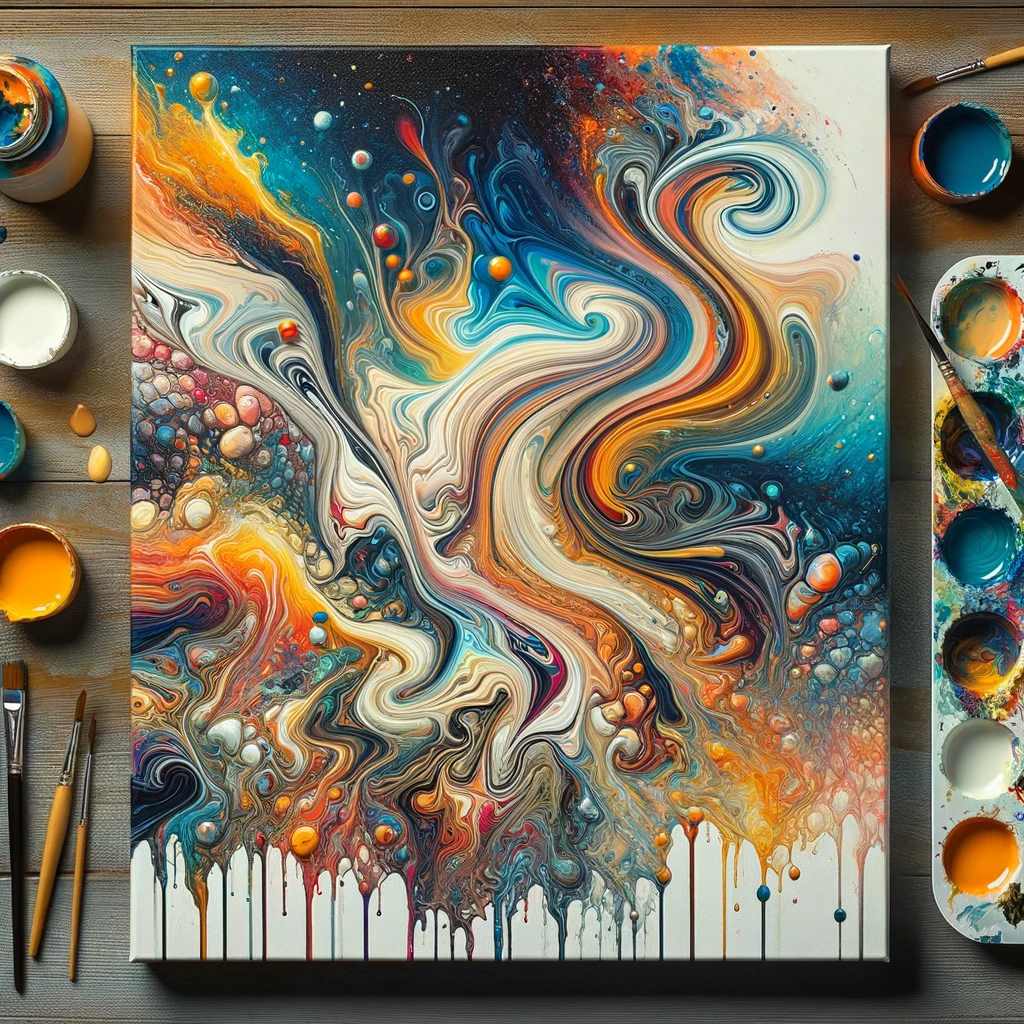 Dripping and Acrylic Pouring for Dynamic Effects: The dripping and pouring techniques in acrylic painting are ways to create dynamic and fluid art. By layering and manipulating wet paint, artists can achieve effects resembling rain, melting objects, or even psychedelic backgrounds. This method is great for those who enjoy experimentation, resulting in marble-like textures or swirling patterns that are unique to each piece.
Dripping and Acrylic Pouring for Dynamic Effects: The dripping and pouring techniques in acrylic painting are ways to create dynamic and fluid art. By layering and manipulating wet paint, artists can achieve effects resembling rain, melting objects, or even psychedelic backgrounds. This method is great for those who enjoy experimentation, resulting in marble-like textures or swirling patterns that are unique to each piece.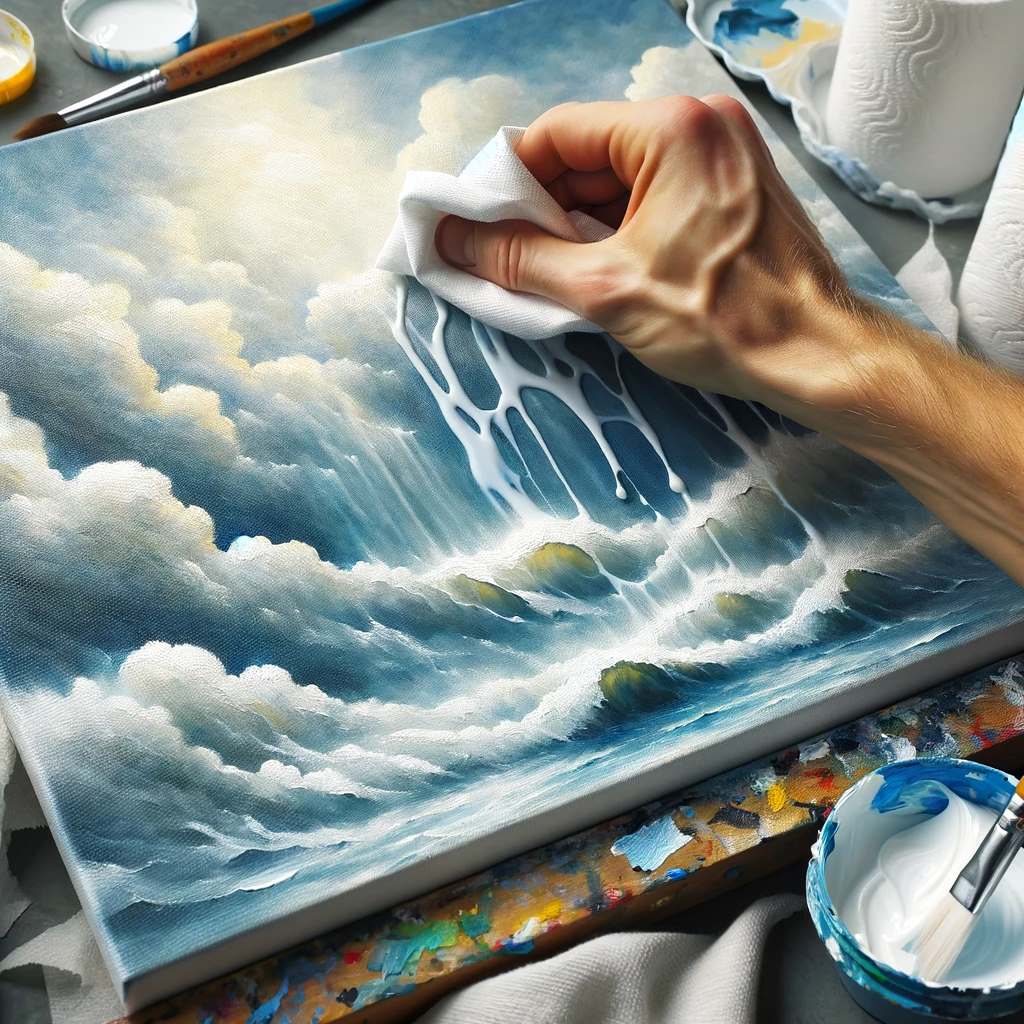 Lifting Paint for Soft Effects: ‘Lifting’ is a technique where wet paint is removed to create soft effects, such as clouds, mist, or reflections in water. This method encourages experimentation with various tools, like wet paper towels or sponges, and is ideal for beginners looking to explore different effects in their paintings.
Lifting Paint for Soft Effects: ‘Lifting’ is a technique where wet paint is removed to create soft effects, such as clouds, mist, or reflections in water. This method encourages experimentation with various tools, like wet paper towels or sponges, and is ideal for beginners looking to explore different effects in their paintings.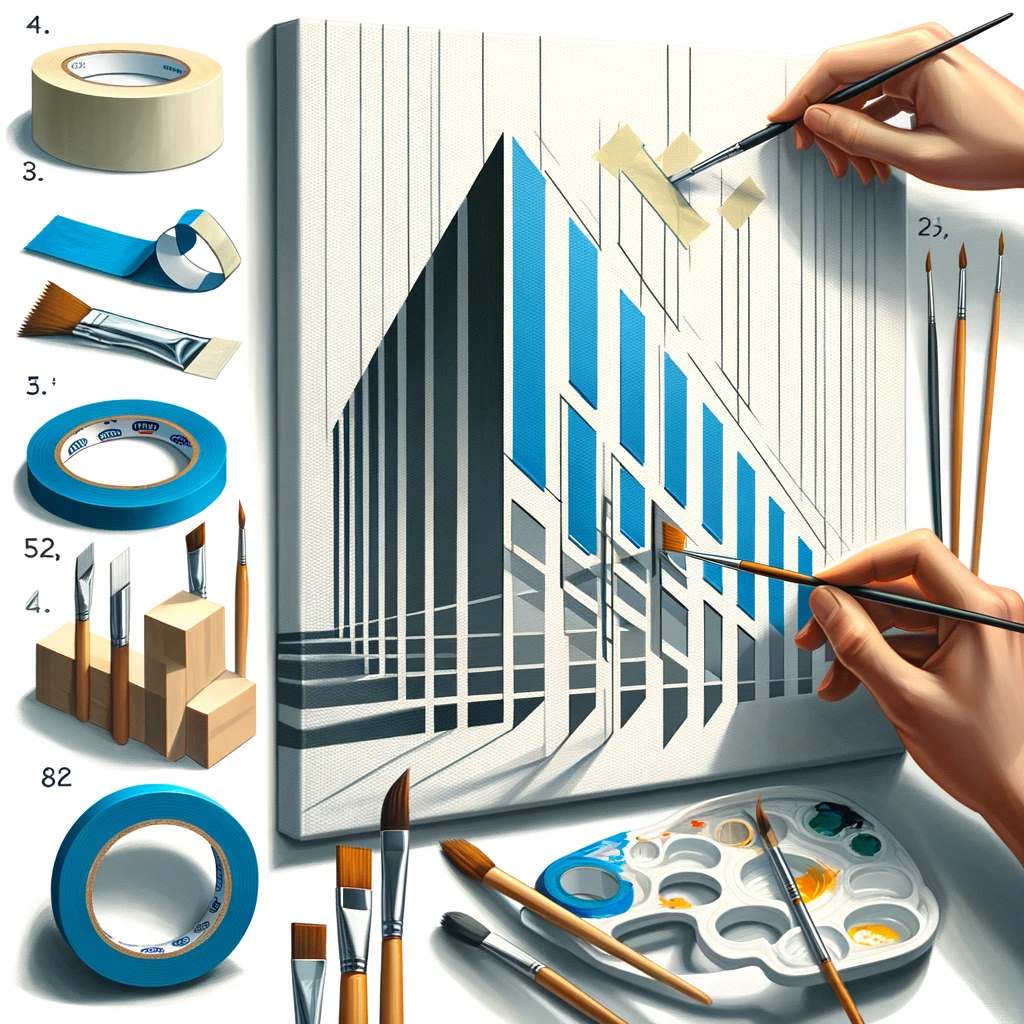 Creating Clean Lines with Painter’s Tape: Painter’s tape can be an invaluable tool for achieving precise lines and shapes. This method is especially useful for geometric patterns, architectural elements, or creating silhouettes, ensuring sharp and neat finishes in your artwork.
Creating Clean Lines with Painter’s Tape: Painter’s tape can be an invaluable tool for achieving precise lines and shapes. This method is especially useful for geometric patterns, architectural elements, or creating silhouettes, ensuring sharp and neat finishes in your artwork. Splatter Painting for Dynamic Textures: Splattering paint onto the canvas can add a lively and natural touch to your work. It’s suitable for depicting elements like starry skies, splashes of water, or sand. This technique can be varied using tools like a sponge or rag to create different splatter effects.
Splatter Painting for Dynamic Textures: Splattering paint onto the canvas can add a lively and natural touch to your work. It’s suitable for depicting elements like starry skies, splashes of water, or sand. This technique can be varied using tools like a sponge or rag to create different splatter effects.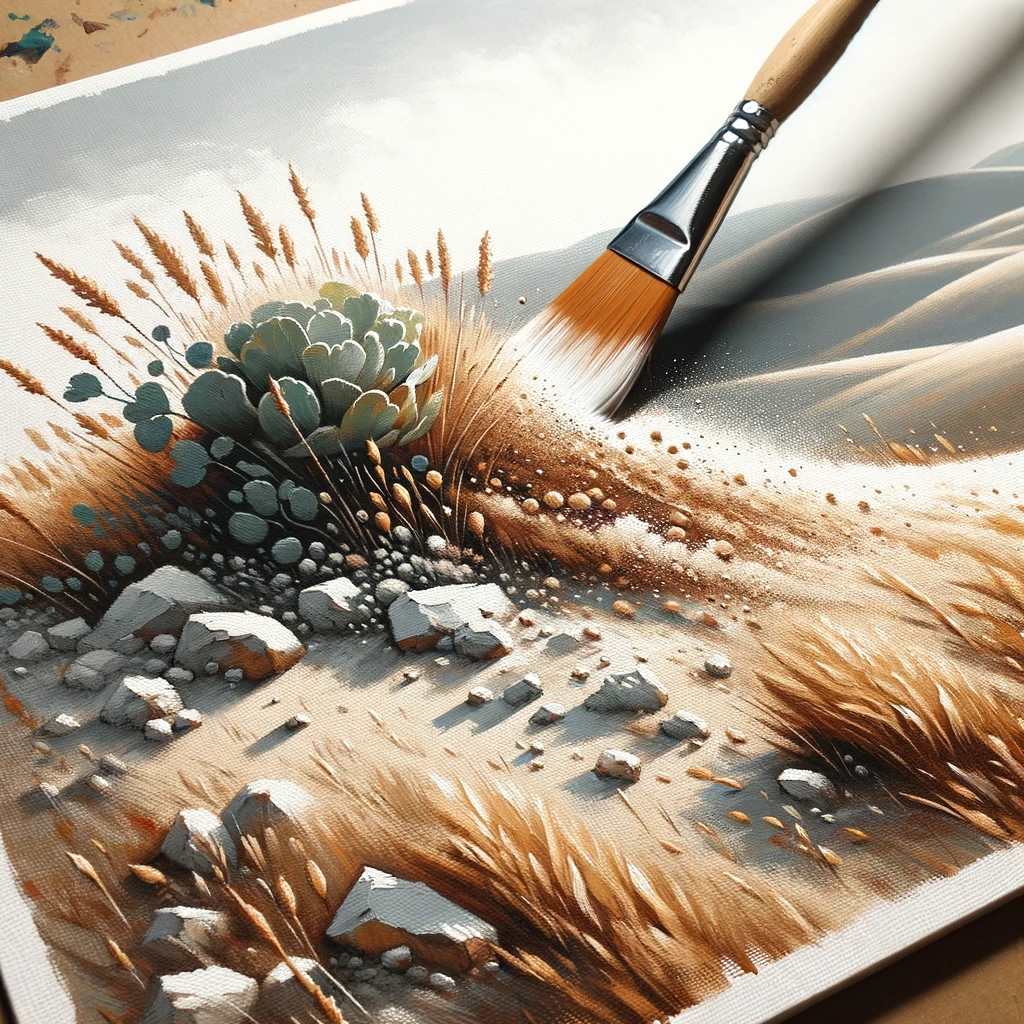 Dry Brushing for Distinctive Textures: Dry brushing involves using a dry brush on a dry canvas. This method is ideal for creating a sense of ruggedness and texture, often used to depict natural scenes or objects with a rough surface. It adds a gritty, realistic touch, enhancing the tactile quality of your paintings.
Dry Brushing for Distinctive Textures: Dry brushing involves using a dry brush on a dry canvas. This method is ideal for creating a sense of ruggedness and texture, often used to depict natural scenes or objects with a rough surface. It adds a gritty, realistic touch, enhancing the tactile quality of your paintings. Using Palette Knives for Creative Textures: Palette knives are not limited to mixing paint; they can also be used to apply paint, creating smooth areas, ridges, or thin lines. The versatility of palette knives offers a range of textural possibilities, from creating thick impasto effects to delicate, smooth finishes.
Using Palette Knives for Creative Textures: Palette knives are not limited to mixing paint; they can also be used to apply paint, creating smooth areas, ridges, or thin lines. The versatility of palette knives offers a range of textural possibilities, from creating thick impasto effects to delicate, smooth finishes.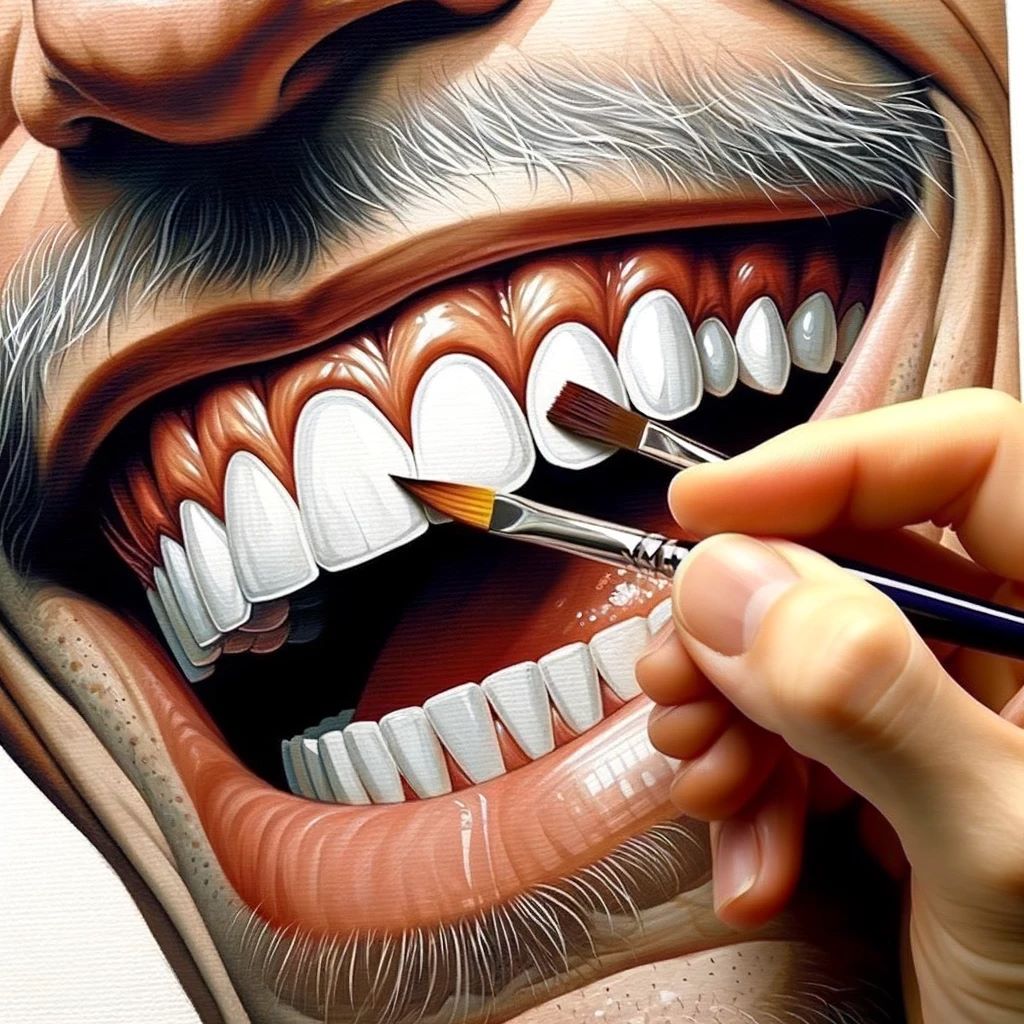 Detailing with a Fine, Wet Brush: For intricate and precise details, a fine, wet brush is essential. This tool allows for the creation of sharp lines, fine points, and delicate outlines, perfect for adding those final touches that bring a painting to life.
Detailing with a Fine, Wet Brush: For intricate and precise details, a fine, wet brush is essential. This tool allows for the creation of sharp lines, fine points, and delicate outlines, perfect for adding those final touches that bring a painting to life. Highlighting Dark Areas with Lighter Paint Layers: Using lighter layers of paint in darker sections of your painting can add depth and dimension. This technique helps in enhancing the overall three-dimensional feel of your artwork, making it more lifelike and dynamic.
Highlighting Dark Areas with Lighter Paint Layers: Using lighter layers of paint in darker sections of your painting can add depth and dimension. This technique helps in enhancing the overall three-dimensional feel of your artwork, making it more lifelike and dynamic.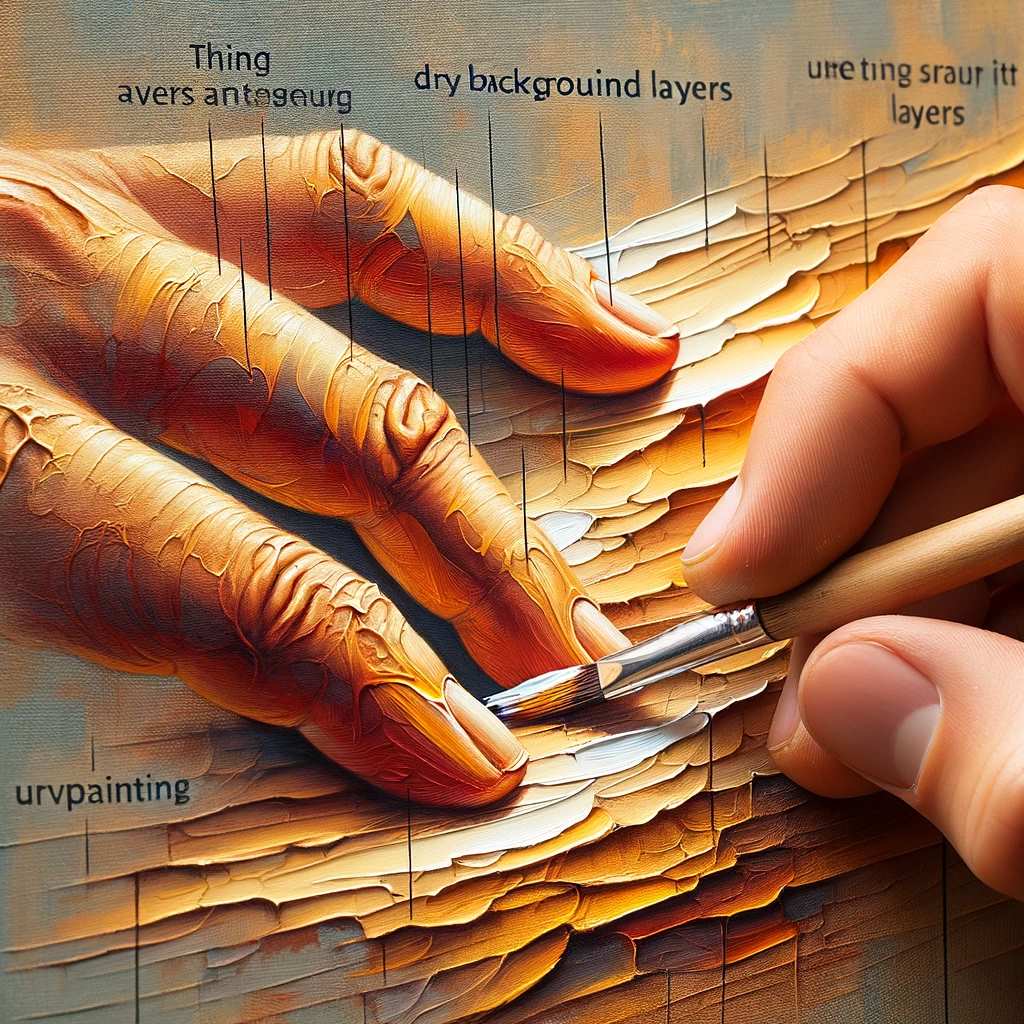 Layering for Depth: The quick-drying nature of acrylic paints is advantageous for layering. This method allows for the creation of underpaintings and subsequent layers, adding depth and complexity to your painting. Layering can also be used to correct mistakes or add details as your work progresses.
Layering for Depth: The quick-drying nature of acrylic paints is advantageous for layering. This method allows for the creation of underpaintings and subsequent layers, adding depth and complexity to your painting. Layering can also be used to correct mistakes or add details as your work progresses.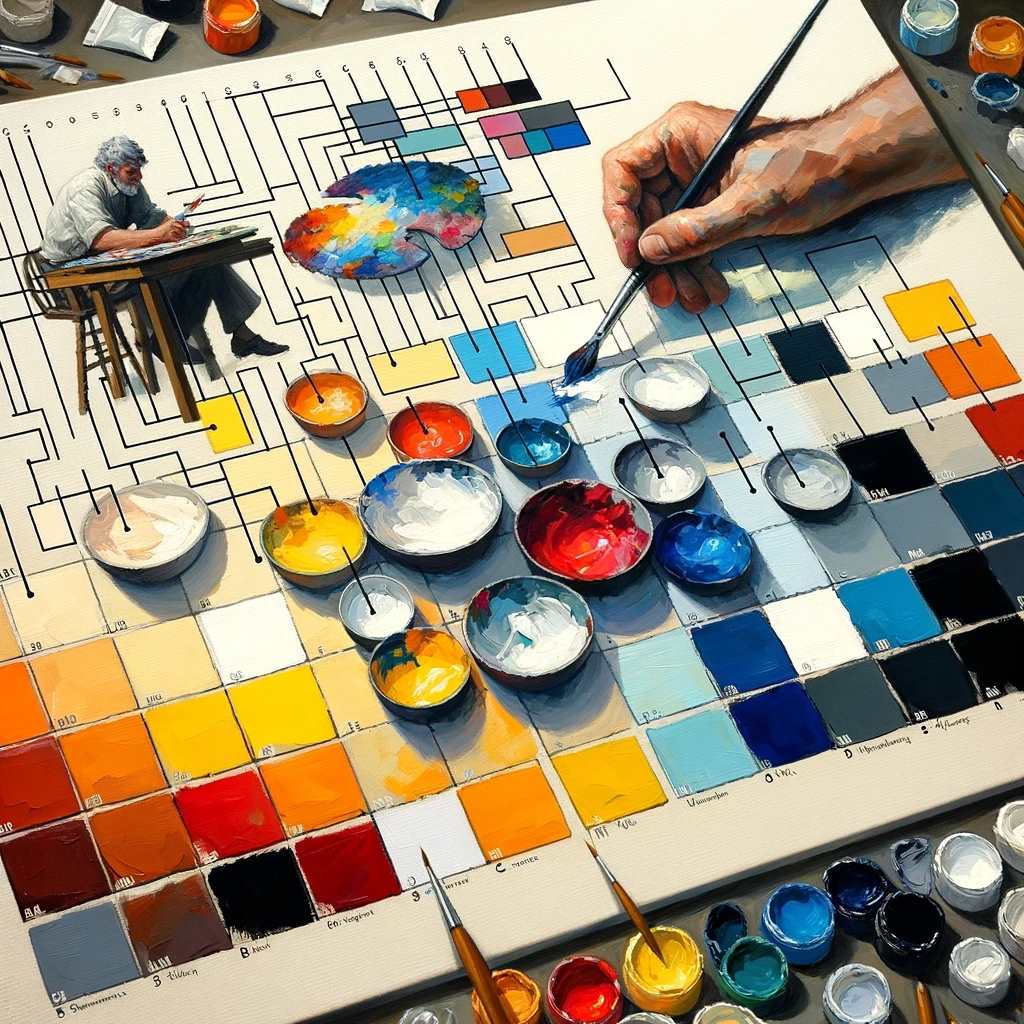 Color Mixing and Charting: Understanding color theory and mixing is fundamental in painting. By mixing primary colors, a wide range of hues can be created. Keeping a personal color mixing chart can be a useful reference for future projects, helping you to recreate specific shades and understand color relationships.
Color Mixing and Charting: Understanding color theory and mixing is fundamental in painting. By mixing primary colors, a wide range of hues can be created. Keeping a personal color mixing chart can be a useful reference for future projects, helping you to recreate specific shades and understand color relationships. Using Varied Tones of the Same Color: Experimenting with different shades and tints of a few colors can produce visually striking results. This approach simplifies the color palette but can create paintings with a strong visual impact, focusing on light, shadow, and form rather than an extensive range of colors.
Using Varied Tones of the Same Color: Experimenting with different shades and tints of a few colors can produce visually striking results. This approach simplifies the color palette but can create paintings with a strong visual impact, focusing on light, shadow, and form rather than an extensive range of colors.